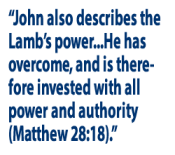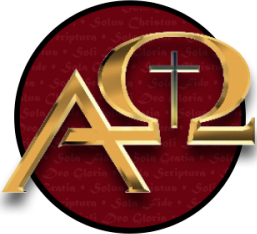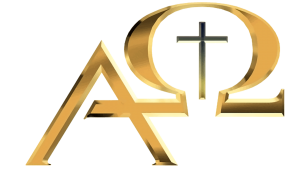The following was first published as an information sheet around 1989.
Jesus Christ – the Lamb of Revelation
(An Examination of the Relationship between God and the Lamb in the Book of Revelation)
John the Apostle was privileged to see things far beyond what any man had seen before. The record of his visions, the book of Revelation, has fascinated man for two millennia. Uncounted debates have taken place over how to interpret the book and what it means. Complicated eschatological speculations have been confidently put forth by all sides, none of which really answer all the questions.
No matter what a person’s position on the end-times teaching of the book of Revelation, each person can come to appreciate the universal message for Christians presented in its pages. In this paper, John’s presentation of Jesus Christ as the Lamb is the focal point of inquiry. Why does the book present Jesus in this way, and how is the Lamb related to God?
To facilitate an examination of these questions, it would be best to follow an already prepared outline of the book itself. Revelation chapter 5 provides us with the majority of information we have about the Lamb, and His relationship with God. I will simply follow the chapter, tying in the information found outside chapter 5 as it relates to the topics at hand.
The Heavenly Scene (Revelation 5:1-4)
We begin in chapter 5 with an awesome scene. Chapter 4 has introduced us to a glorious picture of God on His throne. Around him are twenty-four thrones, and 24 elders. Proceeding from His throne are flashes of lightning and thunderings . There is a sea of glass like crystal, lighted by the torches burning before Him. We see God being praised by all things, and we are awed at the sight.
Chapter 5 introduces the fact that there is a book, sealed with seven seals, in the hand of “Him who sat on the throne.” A search is made in heaven, and on earth, and even under the earth, for anyone worthy to open the book. None is found. It should be noted that even the elders, those sitting in God’s very presence, are not worthy. Obviously, just sinless perfection is not enough to grant the authority to open the book. Here John begins to weep bitterly, for no one can open the book.
The Lion of the Tribe of Judah (Revelation 5:5)
John’s weeping is interrupted by one of the elders who informs him that one has been found who is worthy! He is the Lion of the Tribe of Judah, the Root of David, who has overcome. “The Lion of the Tribe of Judah” is an expression which occurs here only in the Bible.1 It is an expression which points to the royalty and power of Jesus Christ, the true King of Israel.2 We are prepared for a majestic scene of power as we look to see the Lion of Judah.
The Vision of the Lamb (Revelation 5:6)
But what do we see? A Lamb! What irony John here presents! A Lamb that is the Lion of Judah? Indeed! What does all this mean?
First, the very word used here is special. The term is arnion. It means “sheep, or lamb,”3 or “a little lamb.”4 It is used 28 times here in the book of Revelation,5 each time in reference to Christ.6 It is used only one other time outside of Revelation, that at John 21:15. Elsewhere when Christ is called a “lamb” it is the Greek term amnos, not the arnion here found. John seemingly has coined his own special phrase for describing the exalted Christ.7
There is a strong irony presented here, and certainly not by accident. John is presenting the contradiction of Christ, the Creator, God in human flesh, (the Lion), having been slain for the sins of the world. The irony of the Lion being the Lamb is no stranger than God being the sacrifice for man. It is also worthy to note that the Lamb is capable of wrath. In Revelation 6:16 men will cry out for deliverance from the wrath of this gentle creature. John presents it as a terrible thing to be exposed to the Lamb’s anger. Another motif used by John in describing the Lamb is that He is a Shepherd (Revelation 7:17). Again we are somewhat startled at the idea of the one who is normally being shepherded doing the shepherding. “The verb…is normally associated with a shepherd, and is a striking word to use of a Lamb. It marks a complete reversal of roles. So does John make his point that Christ in His sacrifice of Himself makes provision for the needs of His people.”8 Finally, John also describes the Lamb as the Husband of the Church (Revelation 19:7-10). We read of the marriage supper of the Lamb, a great picture of the coming day when the Church, adorned as a bride for her husband, is joined to Him in majestic splendor. Again in this description, John emphasizes the aspect of the sacrifice of Jesus that makes the Church’s redemption possible.9
Returning to the scene of Rev. 5:6, we should note also the position of the Lamb here described. He is “between the throne and the elders” (New American Standard Bible). The Greek could be translated “in the midst of the throne and the elders.” Here “the Lamb is intimately associated with God, for it stands close to his throne.”10 Remember that none were found worthy in heaven or earth to occupy this privileged place. It will soon become evident how closely linked in the mind of the Revelator the Lamb and God truly are.
John sees the Lamb “as if slain.” The tense of the verb is the perfect, which “indicates the lasting effects. The lamb has been offered, yet it stands erect and alive in the sight of heaven.”11 “The Greek perfect tense here signifies that the Lamb was not only slain at a point in time, but that the efficacy of His death is still present in all its power.”12 The picture would show the mark of the slaughter on the Lamb’s neck. This view fits in consistently with John’s desire to point out the pre-eminence of Christ; in His power, and in His sacrifice. In just a short while the elders will sing a song of praise to the Lamb for his having purchased for God men with His own blood. (c.f. Acts 20:28) It is the completely efficacious sacrifice of Christ that undergirds all the actions of the Revelation. God’s anger and wrath are fully justified in that He has offered full and free salvation through Jesus Christ, the Lamb, and mankind has rejected that offer. Only wrath, God’s terrible wrath, can be the result of such an action. Everything John sees, he sees in the light of the Cross, and the shed blood of calvary.
“The levitical system knew of lambs which were slain in sacrifice. But the idea that the Lord of life himself should be the sacrifice, that the Lion of the tribe of Judah should himself be the Lamb that was slain, was almost beyond the imagination of man. In fact it was beyond the imagination of man, but it was not beyond the outreach of the love of God.”13
John also describes the Lamb’s power in this verse. He is described having “seven horns.” This would be a  symbol of the fullness of power, or omnipotence. He has overcome, and is therefore invested with all power and authority (Matthew 28:18). Considering the fact that Jesus Himself said that He would be the one before whom men stand for judgment (Matthew 25/c.f. Psalm 96:13 for another instance of Jesus=YHWH), this very well provides ample evidence of His worthiness and strength for such a mighty task.14
symbol of the fullness of power, or omnipotence. He has overcome, and is therefore invested with all power and authority (Matthew 28:18). Considering the fact that Jesus Himself said that He would be the one before whom men stand for judgment (Matthew 25/c.f. Psalm 96:13 for another instance of Jesus=YHWH), this very well provides ample evidence of His worthiness and strength for such a mighty task.14
Finally, verse 6 tells us of the Lamb’s omniscience. The seven eyes, we are told, are the seven Spirits of God, sent out into the earth. We have seen this metaphor for the Holy Spirit in 1:4. It should not seem strange to the reader that John should indifferently ascribe the Holy Spirit as being Christ’s or God’s. Not only does John scarcely make a distinction between them in Revelation, but Paul himself taught that the Spirit of God and the Spirit of Christ are one in the same (Romans 8:9). Peter, too, understood this in 1 Peter 1:11 when he said that it was the Spirit of Christ that spoke through the ancient prophets. “As is his regular practice, John has freely adapted this passage so that Christ shares the omniscience of God as well as his omnipotence.”15
With no timidity or hesitancy, the Lamb comes and takes the book from the hand of Him on the throne. He has been judged worthy, and the Lamb now becomes the center of attention. “And so we learn that he is the Trustee, the Depository, the alone Revealer of the
Divine will. All truth is in his keeping.”16
The Praise of the Lamb (Revelation 5:8-12)
Immediately upon taking the book, the four living creatures, and the twenty four elders, fall down before the Lamb and begin to praise Him. Here all thoughts of the Lamb’s being a creation of God, or a fellow creature of God’s creation, are permanently banished. The most exalted beings John can picture are found prostrating themselves before the Lamb and worshiping Him. Worship is meant for God alone, as Jesus Himself said (Luke 4:8). But here we see that Christ, as the worthy Lamb, as God incarnate, is worthy of worship. “Each act is meaningful in its own right, but together they show the Christian belief that Christ is deserving the same kind of worship given to God.”17
The elders’ song begins, “Worthy art Thou…” How reminiscent of 4:11 where they sang to God, “Worthy art Thou…” Why is He worthy? “…for Thou wast slain, and didst purchase for God with Thy blood men from every tribe and tongue and people and nation.” The Lamb proved Himself worthy by suffering the voluntary humiliation of the Cross, and by redeeming all of creation with His blood. “It is through his blood that the Lamb is empowered to ransom and save his people.”18 This theme of the blood of the Lamb will be repeated later in 12:11, where it empowers the followers of the Lamb to be victorious. Through His sacrifice, men have access to His book of life (13:8, 21:27).
“This unique and remarkable passage in early Christian literature marks the growing sense and value attaching to Jesus as being far more than a mere national messiah, in fact as the one assurance of God possessed by men, as their pledge of bliss and privilege and pardon.”19
Passages such as this point out the fact that in the Revelation, we see God as the Creator – He is behind everything that happens, and we never quite get away from the description of Him in chapter 4. But we also see, in perfect compliment, the Lamb as Redeemer. As Redeemer, He is worthy of all worship, and He receives just that.
“…this is the overwhelming thought which prostrates the souls of all his redeemed ones in an agony of insolvent gratitude; that he, the Son of God, who was with God and was God, that he should have been content to come hither to this thorn-strewn earth of ours, and to live here the life of a poor, meek man, and then to die upon the cross for us – “herein is love;” and herein is also his supreme qualification to reveal and administer the will of God.”20
But creation is not satisfied with only the praise of the elders and the living creatures! No! In verses 11 and 12 we see that “myriads of myriads” of angels join in the praise. This simply is the best way John could say that an uncountable number of angels were involved.21 “The angels use seven expressions (the perfect number is probably significant) to indicate the wonder of the Lamb.”22 Again our minds are taken back to the picture at 4:11. Such instances on John’s part are not, of course, incidental. Morris notes that almost all of these qualities are used of Christ elsewhere in the New Testament, except for blessing. The verb form of that word is used in conjunction with Christ at Mark 11:9.23
Universal Worship of the Lamb (Revelation 5:13-14)
But even this does not complete the picture. In verse 13 we see the universal worship of the Lamb. Note especially how careful John is to make sure that we understand that this is universal worship. There is nothing in heaven, or on earth, or under the earth (all the places that were searched for someone worthy to take the book in 5:3) that does not join in one huge ascription of blessing, honor and glory and dominion forever and ever to both God and the Lamb for the mighty works They have done. What a glorious scene! Every created thing worships at this time. Obviously, the Lamb is not included, and hence is not a creature nor a creation of God, but stands worthy to receive such worship as God Himself. Robertson notes that “No created thing is left out” by John.24 What a comfort this would be to those Christians to whom John was writing! Suffering under the Roman persecution, they would be thrilled to know that someday, everything in existence would join them in worshiping their Lord! The scene closes not with a fanfare, but with humble and reverent worship. One can almost feel the expectant hush, and holy worship of God and the Lamb. “The worship itself is directed toward Christ the Redeemer as well as toward God the Creator. The Lamb that was slain shares equally with God himself in the adoration of the worshipers.”25
Other Designations of the Lamb in Revelation
Though the fifth chapter provides a clear view of the Lamb, and how He stands in close relation to God, there are a few ideas that should be examined that fall outside the fifth chapter’s realm. For example, the Lamb is identified as the “King of Kings and the Lord of Lords” at 17:14 and 19:16. It is because He is King of Kings and Lord of Lords that the Lamb overcomes the beast and all those with him in 17:14.26 In 19:11-16 we have another thrilling sight of Christ’s majesty. He comes riding on a white horse as the victorious Conqueror. He has a name which no one knows. “He is supreme. His name is known only to Himself.”27 Certainly one can hardly find a more fitting title for Deity. He is the light of heaven, in conjunction with God (21:22-23). Again, “…the Lamb is put on a level with God as the source of light for the heavenly city.”28
In Revelation 22:3 we see that “the throne (singular) of God and the Lamb shall be in it, (the New Jerusalem), and His (singular) bond-servants shall serve (latreuo, divine or sacred worship or service) Him;” (singular again). How fitting! Here John uses singulars to describe the incredible closeness and indeed interpenetration (John 14:9-10) of Father and Son, God and Lamb. Here the Lamb is rendered what only God can ever receive: latreuo. What a glorious message John proclaimed to those first century Christians in their need!
Conclusions
We have seen that John pictures the Lamb in the closest possible union and relationship with God. The Lamb is worshiped like God, is described as God, is shown working the works of God, He has the names of God, and He is served like God. Certainly one can not think of God in the Revelation without at the same time thinking of the Lamb. John began by saying the Word was with God, and the Word was God (John 1:1). He closes with the picture of the Lamb who is with God, and is God. Hallelujah!
Notes:




